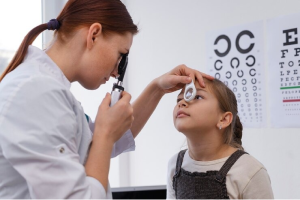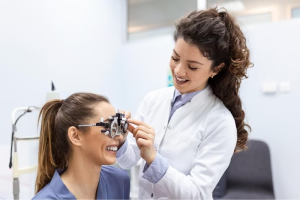Presbyopia is an age-related condition that affects the ability of the eye to focus on objects at close distances. It is a natural part of the aging process and typically becomes noticeable around the age of 40. Presbyopia occurs as the eye’s crystalline lens loses its flexibility and, as a result, its ability to change shape to focus on objects at different distances.
Key characteristics of presbyopia include:
Difficulty with Near Vision:
Individuals with presbyopia often find it challenging to see clearly at close distances, especially when reading, working on a computer, or performing other tasks that require near vision.
Loss of Accommodation:
Accommodation is the eye’s ability to adjust its focus from distant to near objects by changing the shape of the lens. With presbyopia, this ability diminishes, making it harder to focus on close-up objects.
Eyestrain and Headaches:
Individuals with presbyopia may experience eyestrain, headaches, or fatigue, particularly after engaging in tasks that involve close-up vision for extended periods.
Need for Reading Glasses:
One common solution for presbyopia is the use of reading glasses. These glasses have a prescription that helps compensate for the diminished ability of the eye to focus up close.
Difficulty Seeing in Dim Light:
Presbyopia can make it more challenging to see clearly in low-light conditions, and individuals may find that adequate lighting becomes increasingly important for tasks requiring near vision.
Presbyopia is a natural and universal part of aging, affecting virtually everyone as they get older. It is not a disease, and its onset is unrelated to other eye conditions, such as cataracts or glaucoma. While presbyopia cannot be prevented, various corrective measures, such as reading glasses, bifocals, progressive lenses, or contact lenses, can effectively manage the condition and provide clear vision for both near and distant tasks.



Presbyopia is characterized by specific symptoms related to difficulties in seeing clearly at close distances. These symptoms typically become noticeable around the age of 40 and progress with age. Common symptoms of presbyopia include:
Blurred Vision for Close Objects:
One of the primary symptoms is blurred vision when trying to read or perform tasks at close distances. Individuals with presbyopia may find that nearby objects appear fuzzy or unclear.
Eyestrain:
Straining the eyes to focus on close-up tasks is a common symptom. This can lead to discomfort, tiredness, or headaches, especially after prolonged periods of reading or other near activities.
Difficulty Reading Small Print:
Individuals with presbyopia may experience difficulty reading small print, such as text in books, newspapers, or on electronic devices. They may need to hold reading material at arm’s length to see it more clearly.
Needing More Light:
Diminished ability to see clearly in low-light conditions is a symptom of presbyopia. Individuals may find it challenging to read or perform tasks in environments with inadequate lighting.
Problems Seeing in Dim Light:
Presbyopia can make it more challenging to see clearly in dim or low-light situations. This is often associated with difficulty adjusting to changes in lighting conditions.
Squinting:
Squinting is a natural response to presbyopia. By squinting, individuals attempt to reduce the aperture of the eye, allowing them to see more clearly by adjusting the focal point.
Headaches:
Eyestrain and prolonged efforts to focus on close-up objects may lead to headaches, especially if the eyes are overworked during activities that require near vision.
Changes in the Need for Reading Glasses:
People who have never needed glasses for reading or close work may notice a change in their vision, prompting the need for reading glasses or other corrective measures.
Presbyopia is primarily caused by the natural aging process of the eye, specifically changes in the structure and flexibility of the crystalline lens. The crystalline lens, located behind the iris, plays a crucial role in the eye’s ability to focus on objects at different distances. The aging-related changes that lead to presbyopia include:
Loss of Lens Flexibility:
The crystalline lens of the eye undergoes age-related changes that result in a gradual loss of flexibility. This loss of flexibility affects the lens’s ability to change shape, which is essential for focusing on objects at varying distances.
Decreased Accommodation:
Accommodation is the eye’s ability to adjust its focus from distant to near objects by changing the shape of the lens. With age, the lens becomes less elastic, making it more challenging for the eye to accommodate and focus on close-up objects.
Changes in Lens Composition:
The composition of the lens also changes with age. Proteins within the lens may undergo alterations, contributing to a decrease in its elasticity and adaptability.
Weakening of Ciliary Muscles:
The ciliary muscles, responsible for changing the shape of the lens during accommodation, may weaken with age. As a result, the eye’s ability to adjust focus for near vision becomes diminished.
Gradual Onset with Aging:
Presbyopia typically becomes noticeable around the age of 40 and continues to progress with age. By the age of 60, most individuals will experience significant changes in their near vision.
Genetic Factors:
There may be a genetic predisposition to developing presbyopia. If your parents or close family members experienced presbyopia, you may be more likely to develop it as well.
Improved Near Vision: Mr Deshmukh offers treatments tailored to correct presbyopia, enhancing near vision for activities like reading, using digital devices, or performing close-up tasks without the need for reading glasses.
Customized Solutions: Mr Deshmukh provides personalized treatment plans, offering various options such as multifocal intraocular lenses (IOLs), monovision LASIK, or other advanced techniques, tailored to each patient’s specific needs and preferences.
Reduced Dependence on Glasses: Presbyopia treatments by Mr Deshmukh aim to reduce reliance on reading glasses or bifocals, providing patients with greater visual independence and convenience in their daily activities.
Enhanced Quality of Life: Restoring near vision through effective presbyopia treatment contributes to an improved quality of life, enabling individuals to perform tasks comfortably and efficiently at various distances.
Expert Guidance and Care: Mr Deshmukh expertise in presbyopia treatment ensures patients receive comprehensive care, thorough evaluations, and appropriate recommendations, ensuring optimal visual outcomes.
State-of-the-Art Technology: Mr Deshmukh employs advanced technology and modern techniques for presbyopia treatment, offering patients access to cutting-edge solutions for improved vision.
Long-term Vision Improvement: Presbyopia treatments provided by Mr Deshmukh offer long-term vision improvement, allowing patients to maintain clear near vision without the constant need for corrective eyewear.
Patient-Centered Approach: Mr Deshmukh prioritizes patient satisfaction and comfort, guiding them through the treatment process and addressing concerns to ensure a positive experience and favorable outcomes.
1. What is Presbyopia, and how does it affect vision as we age?
Presbyopia is an age-related condition where the eye’s lens loses flexibility, making it difficult to focus on nearby objects. It commonly occurs around middle age, leading to blurry near vision.
2. What are the available treatment options for Presbyopia provided by Mr Deshmukh ?
Mr. Deshmukh offers various treatment options, including multifocal intraocular EDOF lenses (IOLs), monovision LASIK, presbyond LASIK, or he will correctly direct you to use corrective eyewear.
3. How does Mr Deshmukh determine the most suitable Presbyopia treatment for individual patients?
Mr Deshmukh assesses each patient’s eye health, visual needs, lifestyle, and preferences through a comprehensive evaluation to recommend the most appropriate treatment tailored to their specific requirements.
4. What can patients expect during and after Presbyopia treatment with Mr Deshmukh?
Patients undergoing Presbyopia treatment can expect improved near vision. The specifics vary based on the chosen treatment method, and Mr Deshmukh provides guidance on post-treatment care and recovery.
5. Are there any risks or potential complications associated with Presbyopia treatments offered by Mr Deshmukh ?
While Presbyopia treatments are generally safe, potential risks vary depending on the chosen method. Mr Deshmukh discusses potential risks, ensuring patients are well-informed before proceeding with treatment.










